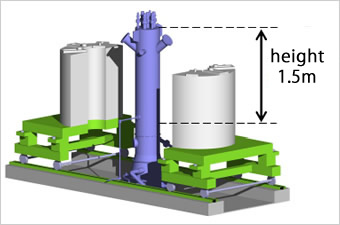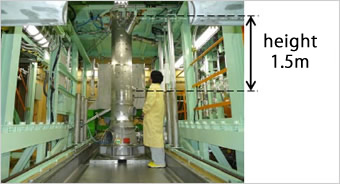TRACY
◎ Purpose of the facility
The objective of the TRACY experiments is elucidation of transient phenomena caused by nuclear power burst and release behavior of radioactive materials in solution fuel treated in fuel reprocessing plants.
◎ R&D activities
The TRACY experiments involve simulation studies regarding transient phenomena and release behavior to evaluate and develop mitigation measures in the event of a criticality accident. (of course, fuel reprocessing plants are carefully designed to eliminate the risk of criticality events).
◎ Contributions
・Contributions to the termination of the JCO criticality accident
The knowledge and experience gained through the TRACY experiments contributed to the termination of the criticality accident that occurred at the JCO uranium fuel fabrication plant in 1999, as well as to its post-accident investigations. The time variation of power and reactivity during the accident was estimated by comparison of the radiation doses observed around the site with the doses measured during the TRACY experiments.
・Contributions to safety design and safety review
The experimental data derived from the TRACY experiments are expected to be utilized for safety assessment and safety review of nuclear facilities, where solution fuel is treated.
・Contributions to human resource cultivation
A video document has been created showing actual observations of the solution fuel in the TRACY core tank during a power burst, and is utilized as educational material for criticality accidents.
・Contributions to R&D of dosimeters
Dosimetry experiments at TRACY also contribute to the development of new dosimeters for criticality accidents.

A diagram of the TRACY core tank

External appearance of the core tank
A snapshot of an actual observation of solution fuel during a power burst from TRACY (No Audio)
◎ Major specifications:
| Name | TRACY (Transient Experiment Critical Facility) |
| Initial criticality | December 20, 1995 |
| The number of operations | 445 (as of March 2011) |
| Dimensions | diameter 0.5 m × height 2 m (T50 core tank) |
| Fuel type | 10% enriched uranyl nitrate solution |
| Maximum thermal power | 10 kW, in static operation (about a millionth part or less of the thermal power of commercial nuclear power plants) 5000 MW, in transient operation |
| Maximum excess reactivity | 0.8$, in static operation 3$, in transient operation ※Unit of reactivity, which is an index for expressing divergence from a critical condition. A sudden increase of fission chain reaction and a power burst, both not controlled by operators, are experienced when reactivity goes over 1$ (Research reactors such as TRACY with an excess reactivity exceeding 1$ must have self-regulating characteristics of reactor power). |
| Features | STACY and TRACY are unique critical assemblies in the world using low-enriched uranyl nitrate solution, which is treated in commercial reprocessing plants. |







